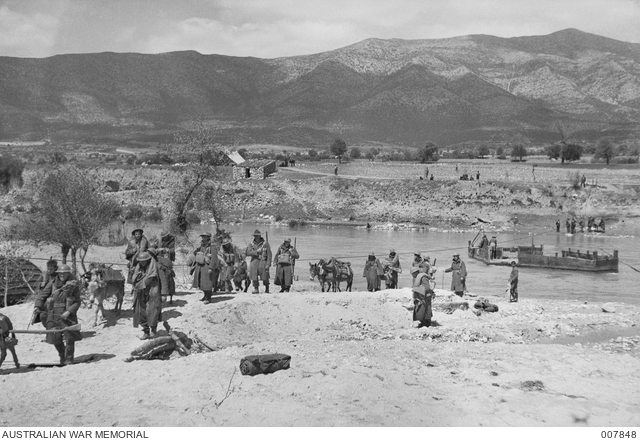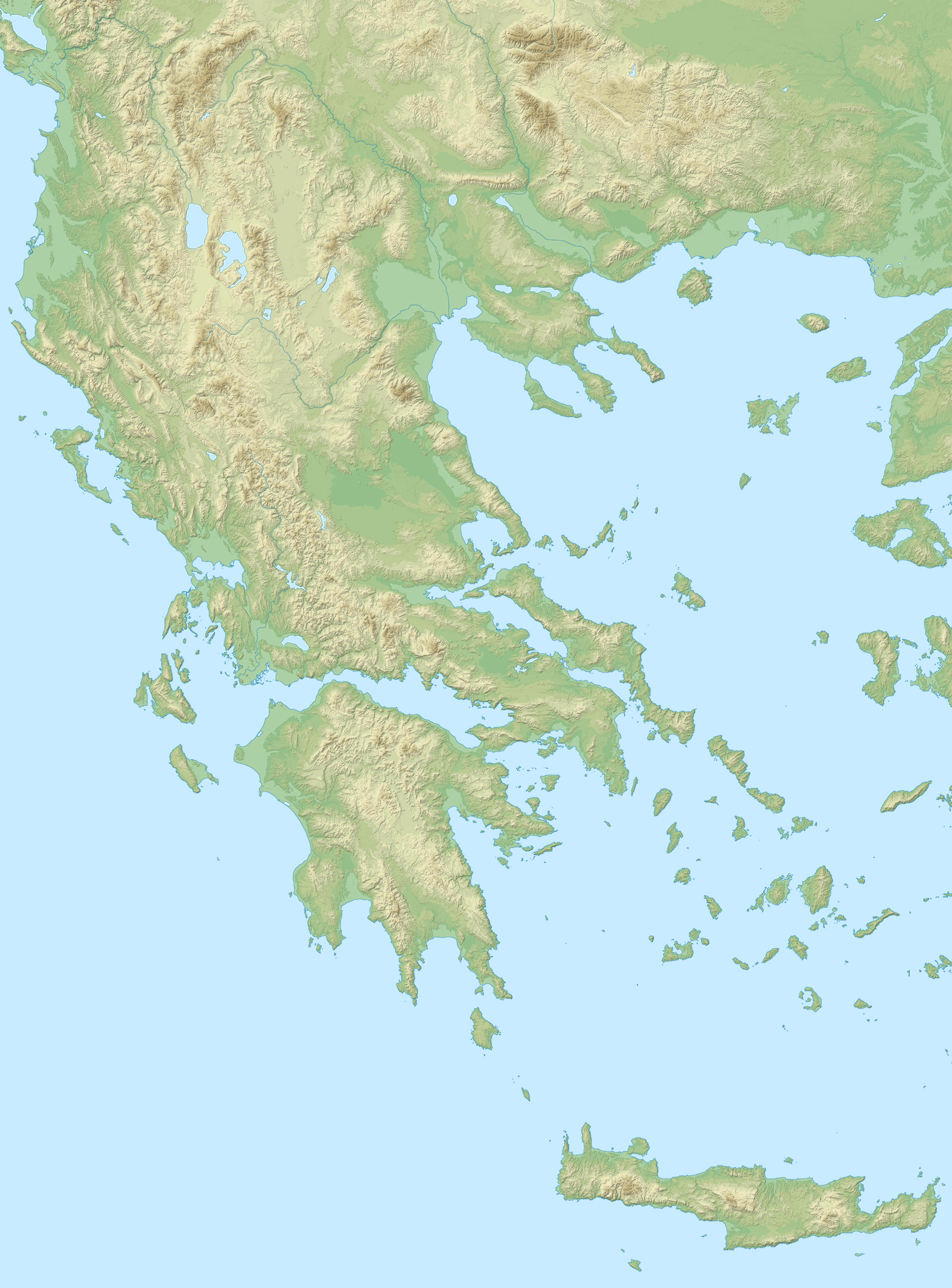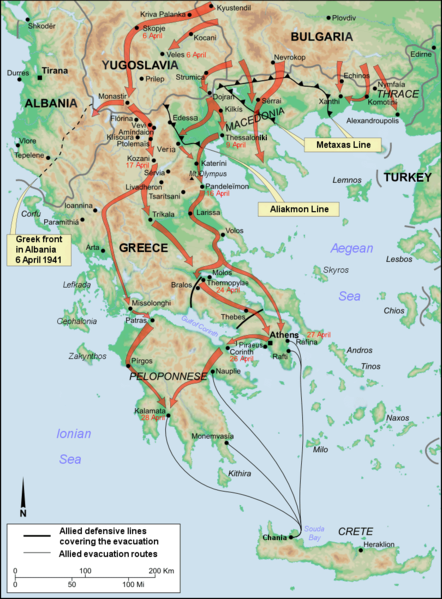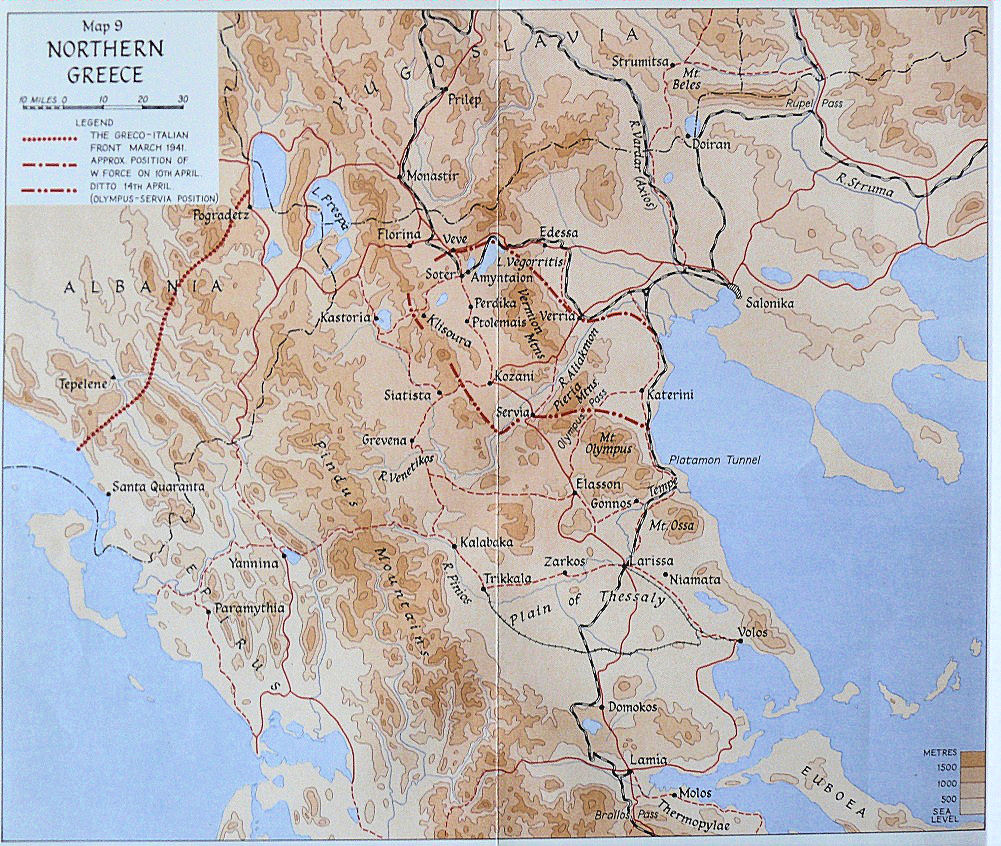Middle East 1930 - 1947:
Greece 1941
In June 1940, Italy declared war on Greece. Italian troops invaded Greece from Albania on 28 October 1940, and after making some initial progress, the Greek forces pushed them back. The situation of the Italian forces became worse, and support was requested from Italy’s Axis partner, Germany. British Prime Minister, Winston CHURCHILL, ordered General WAVELL, C-in-C Middle East, to commence planning for the deployment of Allied troops to Greece.
There was no military strategic imperative to send Allied troops to Greece, it was purely a policitcally strategic decision. At the time, the C-in-C Middle East was managing conflicts on many fronts, including Iraq, Syria, Egypt and Libya, and there was the campaign in East Africa that also impacted on the Middle East Command.
On 18 February 1941, General WAVELL met with the General Officer Commanding Australian Forces in the Middle East, Lieutenant General BLAMEY, as the only suitable troops available to be sent to Greece were the I Australian Corps and the New Zealand Division.
DOWNLOADABLE DOCUMENTS (pdfs)
Chronology of Events
» Chronology of Events Greece 1941
Army Troops
» W Force Troops (Greece) including 1 Armoured Brigade
Divisional Formations
» 6 Australian Infantry Division (1941-42)
» New Zealand Division (1939-41)




It was intended to send the 6 Australian Infantry Division and 7 Australian Infantry Division, together with the New Zealand Infantry Division and Polish Carpathian Infantry Brigade, but, only one of the Australian divisions and the New Zealand Division were deployed prior to the invasion. The British 1 Armoured Brigade was also deployed to Greece as part of ‘W’ Force.
Following the success of Operation Compass in defeating the Italian Tenth Army in Libya, the British War Cabinet decided to send forces to Greece. When Italy declared war on the United Kingdom and France on 10 June 1940, they invaded Greece from Albania (which was under Italian control) in order to gain Greek territory. However, the Greek forces proved too strong for the Italians troops, who were forced back. Initially, the Greek government refused British support, but as the threat from Germany increased, they relented and the British government, led by Winston CHURCHILL, agreed to send ground and air forces to Greece. On 6 March 1941, the relief commenced with units from 9th Australian Infantry Division replacing those from the 6th Australian Division, so they could move back to Egypt and prepare to move to Greece. The 6 Australian Infantry Division was ordered to Greece with the New Zealand Division and 1 Armoured Brigade in March 1941. Known as ‘Lustre Force’ the headquarters of the 6 Australian Division embarked on the S.S. Pennland on 31 March 1941. They arrived at Piraeus at 15.00 hours on 3 April. The divisional commander, Major General Sir Iven MacKAY, K.B.E., C.M.G., D.S.O., V.D. (he had been knighted for his role in the capture of Cyrenaica) met with the staff of I Australian Corps and began deploying his troops accordingly. As the division landed, the German invasion of Yuogslavia was already underway, so he was ordered to hold the Florina Gap. Contact was made with German forces at about 09.00 hours on 10 April 1941 near the Yugoslav border. Due to the nature of the campaign in Greece, the division operated as three infantry brigade groups, supported as and when necessary by divisional resources.
The military situation in Greece collapsed quickly, so by 26 April 1941, the division was embarking to leave Greece. Major General MacKAY flew to Crete to arrange for the deployment of 19th Australian Infantry Brigade on the island. The 19 Brigade arrived on Crete, with the rest of the division being conveyed to Alexandria, where the divisional headquarters arrived at 09.00 hours on 1 May 1941. On 5 June 1941, the units that had served in Crete were reunited with the division in Palestine and the process of rebuilding the formation continued. The 2/1, 2/7 and 2/11 Battalions all suffered heavy casualties, as had the 2nd/3rd Field Regiment, 2/8 Field Company, 2/7 Field Ambulance and 6 Australian Division Supply Company. On 11 June, one company from the 2/3 and 2/5 Infantry Battalions, and the 2/3 Machine Gun and 2/2 Pioneer Battalions were detached from the division and deployed to Lebanon as part of ‘Exporter Force’. The next day, the H.Q. 17 Australian Infantry Brigade was also placed under command of ‘Exporter Force’. Following the armistice, the division continued refitting and reorganising in Palestine, whilst undertaking internal security duties. On 9 October 1941, it commenced moving into Syria to guard against German invasion from the north. The division remained in Syria until February 1942, when due to the Japanese invasion of South-East Asia, and the threat to Australia itself, the division travelled to Suez and embarked for the Far East.
The New Zealand Division was sent to Greece on the orders of the United Kingdom’s Prime Minister, but witht he agreement of the New Zealand government. On arrival in Greece, the division reorganised from brigade groups to the standard divisional establishment. It was deployed on the Aliakmon Line, in North Macedonia. The German Army invaded Greece on 6 April 1941, and the Allies were soon forced to retreat. The New Zealand Division was evacuated from Greece by 28 April 1941 and most units were taken to Crete. The majority of the division’s artillery, transport and other equipment had to be abandoned in Greece. The division suffered some 890 casualties in Greece, of which 291 were killed. In addition, 1,614 New Zealand troops were left in Greece and became prisoners of war.
For further information on the role of the Australian, British and New Zealand forces in Greece, please see:
https://clik.dva.gov.au/history-library/part-1-military-history/ch-2-world-war-ii/s-6-campaigns/greece-crete-and-syria
The map of Greece showing the invasion routes is courtesy of:
https://commons.wikimedia.org/wiki/File:Battle_of_Greece_-_1941.png

